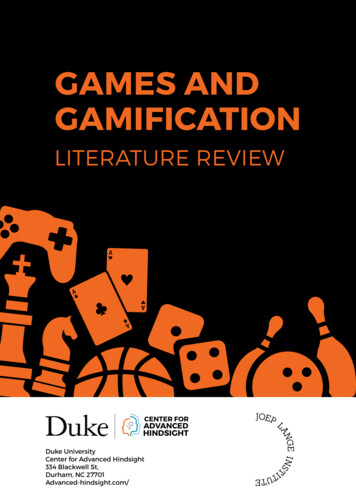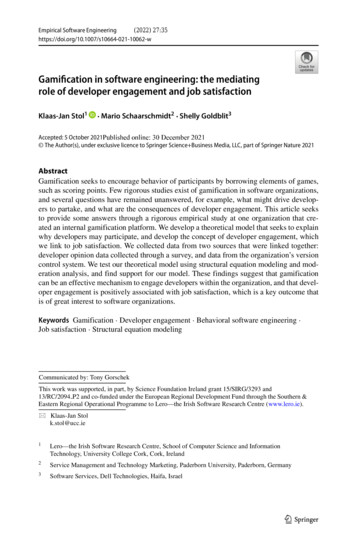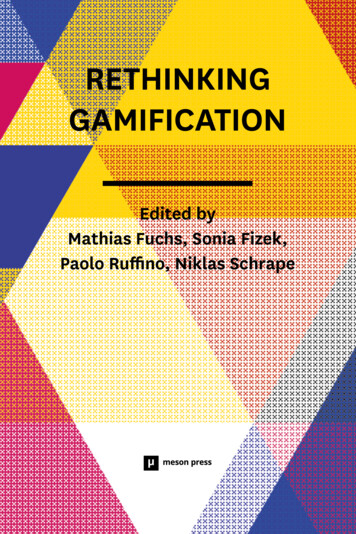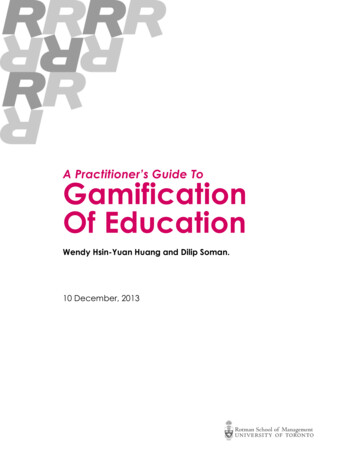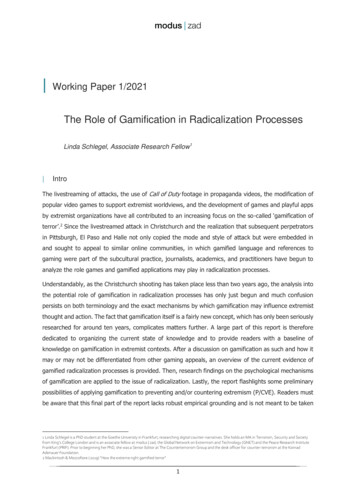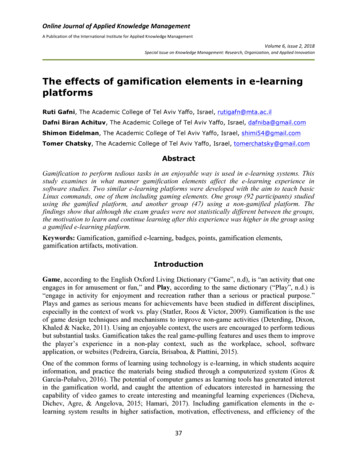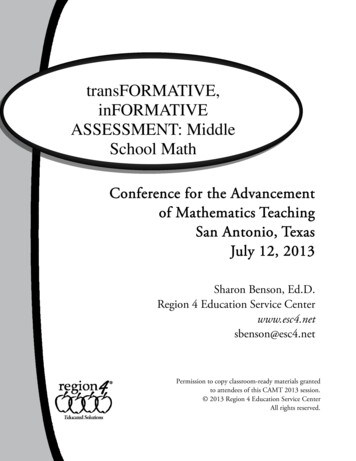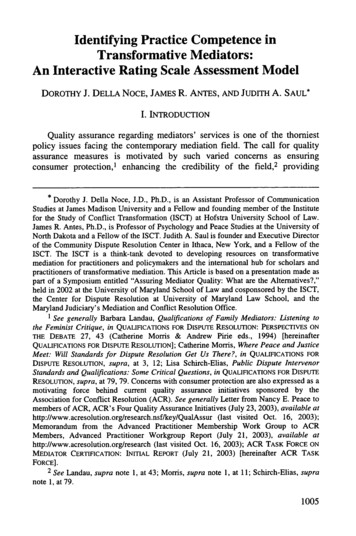
Transcription
HTS Teologiese Studies/Theological StudiesISSN: (Online) 2072-8050, (Print) 0259-9422Page 1 of 15Original ResearchGamification as transformative assessment inhigher educationAuthor:Erna Oliver1Affiliation:1Department of ChristianSpirituality, Church Historyand Missiology, University ofSouth Africa, South AfricaCorresponding author:Erna Oliver,olivee@unisa.ac.zaDates:Received: 16 Feb. 2017Accepted: 03 May 2017Published: 22 Aug. 2017How to cite this article:Oliver, E., 2017, ‘Gamificationas transformative assessmentin higher education’, HTSTeologiese Studies/Theological Studies 73(3),a4527. https://doi.org/ 10.4102/hts.v73i3.4527Copyright: 2017. The Authors.Licensee: AOSIS. This workis licensed under theCreative CommonsAttribution License.Gamification in education is still a very new concept in South Africa. Being a 21st-centuryinvention, it has already established itself in the world within the environs of the corporatemarket, marketing, training and the social world. This article will first discuss gamification(and all its other designations) and its applications in general; thereafter, the focus will be onthe application of gamification within the environment of education, and more specificallywith an emphasis on assessment. The burning question for South Africa is whethergamification can enhance a module or course on the level of higher education so much that aneducational institution cannot do without it anymore, knowing that we are working withstudents belonging to the ‘Digital Wisdom generation’. This article would like to open theway for the implementation of gamification as a transformative online assessment tool inhigher education.PrefaceHumans like to play, and when there is play involved,we become clever and skillful learners.Add the word ‘challenge’ to any activity, and watch people become intrigued.(Monica Cornetti 2015; Gamification World Congress in Barcelona)1In 2001, Marc Prensky (2001:145) introduced the term ‘digital game-based learning’2 as a newlearning paradigm. One year later (2002) the term gamification was coined by Nick Pelling, a BritishIT expert (Marczewski 2012:46; Pappas 2014b:Introduction), in an attempt to make the use ofhardware more fun. The first documented use of the term gamification was in 2008 when‘gameification’ was used in a blog post by Bret Terrill, who was covering discussions in the lobbyat the Social Gaming Summit held that year. He heard the term used in connection with ‘taking gamemechanics and applying to other web properties to increase engagement’ (Terrill 2008). The termwas picked up by other blogs and slimmed down by dropping the ‘e’, becoming gamification (FitzWalter 2013). Gamification became a buzzword in 2011 (Fitz-Walter 2013) to such an extent that theterm made it into Oxford’s Short List for Word of the Year 2011 (Richter, Raban & Rafaeli 2015:22).It relies on the premise that there are certain traditional (educational) activities and learning thatare inherently not interesting, and that, because gaming is fun, game-like features can be introducedto make these otherwise ‘dull activities’ more attractive (McGonigal 2011; Zichermann & Linder2010). Cognisance is taken of the fact that gamification is not restricted to education, but isflourishing in the corporate world as well, at this stage even more than in the educational world.IntroductionGames are played everywhere on earth, and most probably from the beginning of humankind. It isa ‘universal part of human experience and present in all cultures’ (Ifenthaler, Eseryel & Ge 2012:1).Christopher Pappas (2014a) states that more than 75% of people are gamers (50% casually and 27%moderately to fairly often). Although the general perception is that games are mostly played bykids and teens, the New Media Consortium (NMC)3 stated in 2012 in a report that ‘[a]ccording to Trip1.At this Congress Monica Cornetti was voted one of the top 3 finalists for the title of 2015 Gamification Guru of the Year, together withYu-Kai Chou (who won the title) and Andrzej Marczewski. She is rated as #1 Gamification Guru in the World by UK-Based Leaderboarded(Linked in).Read online:Scan this QRcode with yoursmart phone ormobile deviceto read online.2.He defined digital game-based learning as ‘any marriage of educational content and computer games’ (Prensky 2001:145; also cf.Connolly & Stansfield 2011:1766).3.Since 2005, the NMC Horizon Report is an unbiased document supporting educators and others to take note of the impact that keyemerging technologies have on education. This Report also serves as an indication of the time that these technologies are likely tobecome part of mainstream use. The NMC consists of an internationally renowned community of experts in educational technology,including the practitioners who are probing new technologies on campuses on a daily basis, as well as scholars gathering in labs andresearch centres.http://www.hts.org.zaOpen Access
Page 2 of 15Wire Magazine, 61.9 million people participated in onlinesocial games in 2011 Forty percent of these gamers arebetween the ages of 20 and 34. The average age of the Americangamer is now 35-years-old ’ (NMC Report 2012:18). TheNMC supplies a good reason for this: The first digital gameswere created during the 1980s together with the first homecomputers. In the next decade, the web was created, whichintroduced games on the internet. The implication is thatthese children grew up ‘in a world where digital games havealways been an important part of their lives, and entered orgraduated from higher education institutions with hundredsof hours of gaming experience’ (NMC Report 2012:18). KevinWerbach and Dan Hunter (2012:8) confirm that it is thegeneration that is entering the corporate market that playsgames the most. In 2014, the NMC reports that the age of theaverage gamer is 30, while 68% of all gamers are older than18 – university age (NMC 2014:42). Knewton (sa) states thatworldwide, people spend more than 3 billion hours per weekgaming on a mobile device.Gamification can shortly be defined as an ‘integration ofgaming elements, mechanics, and frameworks into nongame situations and scenarios’ (NMC 2014:42). It relates to anancient concept in which games were used to support(learning) objectives (Rapti 2013b:92). A few more definitionsare added to this one (together with two negative comments!)for the reader to understand this phenomenon even better: Sebastian Deterding (2011) describes it as the use of gameelements in a non-gaming context. Gabe Zichermann and Christopher Cunningham(2011:xiv) define gamification as ‘[t]he process of gamethinking and game mechanics to engage users and solveproblems’. Zac Fitz-Walter (2013): ‘Gamification describes theframing [of – my addition] an activity like a game to makeit more motivating. The concept of gamification isn’t new,but the term describing it is’. Kalliopi Rapti (2013a:255–262) defines it comprehensively:‘So, fundamentally gamification is the use of game-basedmechanics, aesthetics and game thinking to engagepeople, motivate action, promote learning, and solveproblems. That is why it can be used as an alternative wayof assessing students [my italics]’. This was actually just anelaboration of the definition given to gamification by KarlKapp in 2012/2013 (Kapp 2012; 2013a). In 2015, Vivek Bhide gave the most comprehensivedefinition to date: ‘Gamification is the use of gamemechanics and game design techniques in non-gamecontexts. Typically gamification applies to non-gameapplications and processes, in order to encourage peopleto adopt them, or to influence how they are used.Gamification works by making technology moreengaging, by encouraging users to engage in desiredbehaviors, by showing a path to mastery and autonomy,by helping to solve problems and not being a distraction,and by taking advantage of humans’ psychologicalpredisposition to engage in gaming. The technique canencourage people to perform chores that they ordinarilyhttp://www.hts.org.zaOriginal Researchconsider boring, such as completing surveys, shopping,filling out tax forms, or reading web sites’. Negative comments: Margaret Robertson (2010) says,‘Games are good, points are good, but games points’and Ian Bogost (2011) calls gamification bullsh*t.The history of games/gamificationin a nutshellGames and play, as indicated above, have a very longhistory. Arthur Krentz (1998) shows that Plato already, in hisRepublic (written in the 4th century BCE!), indicated a closeconnection between play (paidia) and education (paideia).However, during the Middle Ages and the Early ModernAges, games lost this positive attribute and were consideredto be evil and a waste of time (cf. Parmentier 2004). ImmanuelKant (1803) was also negative towards games, indicatingthat games do not have any positive influence on formaleducation. The 19th century saw a turnaround as FriedrichFröbel (the founder of kindergartens – cf. Ifenthaler et al.2012:2) started to develop special games for children toeducate them. The 20th century shows further progressionon this topic, when Sigmund Freud used games to help hispatients overcome psychological problems (Freud 1920). In1955, Johan Huizinga wrote a book, Homo ludens: A study ofthe play-element in culture. This book was regarded to be amajor piece of research on game theory (Ifenthaler et al.2012:2).Up to half a century ago, all the games being played were‘manual games’ – these are games not played on aresponding/interactive device like a machine/computer.The epistemology of ‘only children play games’ started tochange in the early 70s of the previous century when arcadegames, also known as video games, were introduced by AtariInc. through their first game, Pong, a two-dimensional tennisgame (Timetoast na). This opened a whole new way ofengagement in gaming, as, for the first time, a human playeda game against/with a machine. Although this game and itsfollow-ups were mostly played by teenagers, students soongot involved. During the past more than 40 years, videogames have grown to ‘comprise a massive global industrythat generates 70 billion per year’ (Werbach & Hunter2012:8). During this time, gaming on machines have extendedto TV games, home video games, computer games and gameson consoles. From the start of the 21st century ‘digital toolsand portable devices have enabled gaming to become amobile and social activity’ (Higher Education Academy[HEA] 2015). Soon after the arrival of (specifically) thesmartphone in 2007 (Arthur 2012), ‘everybody’ started toplay games on their mobile devices, from children aged 3 and4 to ‘aged’ people in their sixties and seventies. Reasons forthat are: (1) the games can be downloaded for free and (2) onecan play it in one’s private space and at any desired time.The first game that was played on a cell phone was the snakegame in 1996 (Timetoast na). Many other games soon followed.In the 21st century and more specifically in the second decadethereof, gamification became a buzzword and becameOpen Access
Page 3 of 15implemented on a rapid basis (Fitz-Walter 2013). During thisera, games were no longer only played by individuals, but bya worldwide group of competitors, introducing proper onlinegaming. Games were not merely played just for fun, but togain experience points (XP) and badges and achieve highrankings. Although Timetoast (na) traces online gaming backto 1969 (!), it only became really effective in 2001 with theintroduction of Xbox 1, which is a playstation.In 2007, Bunchball launched the Nitro platform that made itpossible for organisations and individuals to integrate socialnetworks into gaming (Fitz-Walter 2013). This was succeededin 2009 by the Foursquare application. This social networkapplication included gaming elements like points, badgesand leader boards which became the ‘blueprint for futuregamification designs’ (Fitz-Walter 2013). In 2010, companiessuch as Bunchball and Badgeville adopted the term gamificationin describing the platforms created by them to integrate gameelements into their sites. More sites and applications wouldfollow, like the Epic Win app (Fitz-Walter 2013). AnnualGamification Summits in San Francisco (20–21 January 2011)and New York (15–16 September in the same year), followedby many more in the following years, would testify to theprominence of gamification.4 Already in 2011, the New Yorksummit was advertised as follows:Gamification Summit NYC is the must-attend event that showsyou how to use the power of games to create breakthroughengagement with your customers and employees. Companieslike Gilt Groupe, Google, Microsoft, NBC/Universal, Scholastic,MTV, Recyclebank and Aetna have leveraged gamification totransform their businesses, and will share startling insights,statistics and hands-on workshops at GSummit NYC. (XingEvents 2011)In the academic world, gamification also became a point ofinterest, especially after a workshop of the Conference onHuman Factors in Computing Systems (CHI) in 2011 inVancouver, BC, titled ‘Gamification: Using Game DesignElements in Non-Gaming Contexts’. Scholars like KaliopiRapti (2013a:255–262) as well as Andrew Stott and CarmenNeustaedter (2013:1–8) linked gamification to transformativeassessment.In 2012, gamification hit a low as people got wary/weary ofthe old type of gamification with badges and more badges(Fitz-Walter 2013). However, this was turned around in2013, which was named by Fitz-Walter (2013) as the yearof gamification, and since then gamification never lookedback again.What’s in a name?Original Researchthis article, who plainly refer to games for educationalpurposes as gamification, there are those like Elliott Bristow(2015) who regard gamification as a controversial topic. BrianBurke, giving a good overview of how to gamify innovation,in his discussion of gamification, has decided to stay with theterm (Burke 2014). Sydney Butler has a quite different view.In his YouTube video, he refers to gamification as ‘anapproach that facilitates behavioural change’ (Butler 2015).5He demonstrates this definition by indicating thatgamification has all the elements of pure gaming in it, butthat it is not a game per se.Andrew Miller (2011a; 2011b) and Steven Isaacs (2015) bothmake a clear distinction between gamification and gamebased learning (GBL) and, in the end, both choose for GBL asthe correct way of teaching students through games. VickyDavis (2014; also cf. HEA 2015) also opts for GBL. On thecontrary, Botturi and Loh (2008:1–22; cf. Loh 2012:126) regardGBL as an old tradition of gaming that has just been revived.Richter et al. (2015:22) prefer the term serious games: They wantgamification to develop into a serious game. Whereas, themain focus of games is to entertain, serious games ‘are gamesconceived to educate and not necessarily to entertain, althoughthey might be entertaining as well’ (Barata et al. 2015:2; cf.Michael & Chen 2006; Ritterfeld, Cody & Vorderer 2009:6).Sawyer and Smith (2009) as well as Jantke (2012:86) believethat almost every game is a serious game, as there is a seriouselement in every game. Barata et al. (2015) make the followingdistinction between gamification and serious games:Gamification differs from (serious) games in that the latterconsist of using full-fledged games (without a purpose beyondentertainment), which usually simulate real-world or fantasyscenarios and events, while the former adopts game designelements (only) in contexts or processes that are not games usually encompassing real-world activities. However, bothallow for gameful interactions. (p. 2)Ghergulescu and Muntean (2012:356) argue in the same veinstating that serious games also include games such as gamesfor health and training, which do not necessarily includegame-play elements. Gebremichael (2016:12) defines seriousgames as ‘games that are used to simulate real world events inorder for the player to solve problems’. The umbrella term heuses is educational games, which are ‘[g]ames that are designedto assist the player to learn about a specific subject, reinforcedevelopment or learn new skills’ (Gebremichael 2016:12). Hethen classifies serious games and gamification under thecategory of educational games. Rapti (2013b) also draws aclear line between gamification and serious games. Withreference to Gåsland (2011), she explains:There seems to be no clarity among scholars on which termto use when referring to the implementation of games foreducational purposes. Although many scholars prefer theterm gamification, there are those who choose to use other‘better’ designations. Apart from all the scholars discussed inSerious games serve a pedagogical purpose by using gameproperties towards this purpose, thus they are still considered agame but with an educational context. They are also developedby game designers and come in the form of simulations. Whenusing gamification you are not in a virtual world but in the realone. (Rapti 2013b:92–93)4.Very interesting is that before the end of the San Francisco summit, on 20 January2011, the New York summit was already fully booked!5.Maybe Barata et al. (2015:1) articulated it better: ‘Gamification draws on themotivational qualities of games to entice users to adopt specific behaviors’.http://www.hts.org.zaOpen Access
Page 4 of 15She adds:Gamification comprises of game mechanics, which are the basicprocesses, and rules, which gamify an activity, like points,challenges (sic), leaderboards, levels, virtual goods and gifts,that in turn lead to motivations of the experience, i.e. gamedynamics, such as rewards, achievement, competition, status,self-expression, and altruism. (Rapti 2013b:93)With reference to Kapp (2013b), she distinguishes betweentwo types of gamification, namely structural and content, andalso refers to the use of both for education. When usingstructural gamification, the structure is gamified around thecontent (which remains unchanged), while the progress ofthe learner is constantly rewarded. Content gamification hasthe aim to change the content to be more game-like. Thelecturer will use the structural gamification to motivate thelearners to make use of the content on a continuous basis,while she or he will use the content gamification to introducenew knowledge. These two forms of gamification can also becombined, with the obvious better results.Wilson et al. (2009) distinguish between a game and asimulation, showing that one should be very clear aboutthese two terms. They define a game as ‘an artificiallyconstructed, competitive activity with a specific goal, a set ofrules and constraints that is located in a specific context’(Wilson et al. 2009:218; cf. Hays 2005) and a simulation as ‘aserious attempt to accurately represent a real phenomenon’(Wilson et al. 2009:218; cf. Crawford 1984:8). Other namesused to describe gamification are ‘games for education’,‘educational games’, ‘gaming for education’ and ‘gamifiededucation’ (Butler 2015).For the purposes of this article, the author prefers theterm gamification when referring to games, gaming, seriousgaming, etc. for educational purposes.A ‘compact’ literature overview6The literature on gamification has escalated by leaps andbounds in the 21st century. Articles, books, e-books and postson the internet (including YouTube videos and blogs) haveincreased exponentially during the second decade of thiscentury. According to Ifenthaler et al. (2012:2), approximately20 000 publications that focus on games in social science sawthe light between 2004 and 2014. In this overview, someimportant publications of the past 10 years are provided to givethe reader an indication of the ‘feel in the field’.In the marketing and business world, specifically in the US,gamification is almost synonymous with clients andemployees, as both these groups are rating themselves andare rated by companies on a continuous basis, implying thatthey are gaming on an almost continuous basis. GabeZichermann and Christopher Cunningham published a bookin 2011 titled Gamification by Design, showing that the use ofgame design elements in non-game contexts has managed to6.For another (older) literature review, cf Thomas Hainey, Thomas Connolly, MarkStanfield and Liz Boyle (2011:29–50).http://www.hts.org.zaOriginal Researchgrow from a self-description used by some proponents to aplacement on the Gartner hype cycle (Gartner 2011).7 In 2012,Kevin Werbach and Dan Hunter published a book onbusiness gamification in the USA, showing their readers howgame thinking can revolutionise a business: ‘A well-designedgame is a guided missile to the motivational heart of thehuman psyche. Applying the lessons that games can teachcould revolutionize your business’ (Werbach & Hunter2012:8).8 In 2013, Gabe Zichermann teamed up with JoselinLinder to publish a book on games-based marketing settingthe trend for active marketing through gaming (Zichermann &Linder 2013). Also in 2013, the NMC Report refers in a positiveway to gamification in the workplace (NMC 2013:20, 21).9 In2014, Ella Hafermalz and Kristine Dery discussed theadvantages of gamification as a ‘useful tool for engagingtalent in recruitment, training, and skills assessment’(Hafermalz & Dery 2014).In the academic world, Sebastian Deterding10 was one of thefirst academics to talk about gamification, and he is stillpresenting papers worldwide. He was also one of the firstscholars to warn against the potential pitfalls of gamification.After he has published his book in 2011 as a response toZichermann, in the same year he teamed up with RillaKhaled, Lennart Nacke, Dan Dixon, Miguel Sicart andKenton O’Hara in delivering three very positive papers ongamification at the annual Conference on Human factors held inVancouver, BC. Jesse Schell’s presentation at the Dice Summit201011, named When games invade real life, and Jane McGonigal’sTechnology, Entertainment, Design (TED) Talk12, Gaming canmake a better world, helped to spur this area on as well. It wasshe who made the disruptive statement, ‘Reality is broken,game designers can fix it’ (McGonigal 2010; 2011).In 2012, Karl Kapp published a major work on the gamificationof learning and instruction, followed by a publication in 2014by himself, Lucas Blair and Rich Mesch, in which they put7.Gartner, Inc. (NYSE: IT) is the world’s leading information technology research andadvisory company. They deliver the technology-related insight necessary for theirclients to make the right decisions, every day. In 2011 they released the ‘Hype CycleSpecial Report Evaluates the Maturity of 1900 Technologies’ (Gartner 2011).Sebastian Deterding criticised the book and provided a very detailed breakdown ofthe book later in 2011 (Deterding 2011).8.On the same page they added: A well-designed game is a guided missile to themotivational heart of the human psyche. Applying the lessons that games can teachcould revolutionize your business fun is an extraordinary valuable tool to addressserious business pursuits like marketing, productivity enhancement, innovation,customer engagement, human resources, and sustainability. We are not talkingabout fun in the sense of fleeting enjoyment but the deep fun that comes fromextended interaction with well-designed games Organisations whose employees,communities, and customers are deeply engaged will outperform those that cannotengender authentic motivation.9.The Report (NMC 2013) stated the following: ‘Social networking features of mobilegames support the prevalence of game play in a culture that is increasinglyconcerned with staying in touch and being connected all of the time; in this sense,the appeal of online games is not just about who is playing, but who in one’spersonal network is playing – and winning It is not uncommon now for majorcorporations and organizations, including the World Bank and IBM, to consult withgame experts to inform the development and design of large-scale programs thatmotivate workers through systems that incorporate challenges, level-ups, andrewards. While some thought leaders argue that the increasing use of game designin the workplace is a short-lived trend that yields short-term bursts of productivity,companies of all sizes in all sectors are finding that workers respond positively togamified processes’ (pp. 20, 21).10.See his website http://codingconduct.cc/11.See http://www.ted.com/talks/jesse schell when games invade real life12.See http://www.ted.com/talks/jane mcgonigal gaming can make a better world.See also her video on http://www.avantgame.com/Open Access
Page 5 of 15the ideas of his previous book into practice, calling the bookThe Gamification of Learning and Instruction Fieldbook: Ideas intoPractice. Yigal Attali and Meirav Arieli-Attali (2015) evaluate(in two studies) the effects of one particular gamificationfeature, namely points, ‘on different aspects of performancein the context of an educational assessment’ (Attali & ArieliAttali 2015:58). In these two studies, the effects of points ondifferent aspects of performance within the field ofeducational assessment are described. The form of assessmentused by the scholars focused on the ‘mastery and influence ofbasic mathematical concepts’ (Attali & Arieli-Attali 2015:58).13In 2016, Daniel Gebremichael submitted his MSc dissertationin which he examines the use of gamification to develop anassessment tool, specifically on first-year students incomputer science. In his dissertation, he elaborates quiteextensively on how to create and develop a game forassessment purposes (cf. Chapters 4 and 5 of his dissertation),and then he tests it on his students (chapter 6) with verypositive outcomes. However, his dissertation is very technicaland not suitable for further discussion in this article, otherthan to say that we took cognisance of it.Despite much literature on the specific mechanisms relatingfeedback to performance (Hattie & Timperley 2007; Kluger &DeNisi 1996), the concept is still not well investigated andunderstood (Attali & Arieli-Attali 2015:58). Findings andmeta-analyses on the concept describe the results asinconsistent, contradictory or highly variable (Attali &Arieli-Attali 2015:58; Azevedo & Bernard 1995; Kluger &DeNisi 1996).In academia, there are two main lines of argumentation ongamification, namely the ludologists and the narratologists(Werbach & Hunter 2012:9). Gonzalo Frasca (in 1999) andMatthew Tyler-Jones (in 2013) discuss these terms:14 Ludology: Ludology means ‘game studies’ or ‘gamedesign’ (Gebremichael 2016:16). This term was coined byeither Henry Jenkins (2004) or Espen Aarseth (1997).According to this view, games should be understood ontheir own terms, and therefore, the study of games shouldfocus on the rules of the games and not on the way it ispresented. Narratological view: Games can also be regarded asnovel forms of narrative. It can, therefore, be researchedby using theories of narrative, as narrative is an importantdesign element for games in general (cf. Dickey 2006:17;Gebremichael 2016:16).During the second decade of the 21st century, quite a few bookswere published on the relation between gamification andassessment. The most recent book known by the author of13.This formed the part of the CBALTM (Cognitively Based Assessment of, for, and asLearning) research initiative in which assessments are developed to create the bestenvironment for positive effects on teaching and learning (Attali & Arieli-Attali2015:58; cf also Arieli-Attali & Cayton-Hodges 2014; Bennett 2011).14.See Frasca 1999. http://www.ludology.org/articles/ludology.htm. See -vs-narratology/. On the topicof Narratology versus Ludology, see Aarseth (1997), Jenkins (1992; 1993; 2004)and Ritvo (1998).http://www.hts.org.zaOriginal Researchthis article is published by Harold O’Neil Jr, Eva Baker andRay Perez in January 2016 on key issues regarding theutilisation of gaming in assessment. However, the book ismore directed to ‘computer scientists interested in thescientific and practical approach to computation and itsapplication’ (O’Neil, Baker & Perez 2016: preface). Anoutstanding book to be mentioned here, concerningassessment in education (GBL), is written by Dirk Ifenthaler,Deniz Eseryel and Xun Ge in 2012. This book, beingextensively discussed in this article, consisting of 21 chapterswritten by almost 50 scholars on assessment, is divided intothree parts: Part 1: Foundations of Game-Based Assessment. Part 2: Technological and Methodological Innovations forAssessing Game-Based Learning. Part 3: Realizing Assessment in Game-Based Learning.Worthy to be mentioned here are The Horizon Reportspublished annually from 2005. The NMC Academy haspublished these Reports in collaboration with the EDUCAUSELearning Initiative (ELI):Each year the Horizon Advisory Board researches, identifies andranks key trends affecting the practice of teaching, learning,research, and creative expression. The Board reviews currentarticles, interviews, papers, and new research to discoveremerging or continuing trends. (The Horizon Report 2009:5)In the 2008 edition (the fifth edition of the Horizon Report),games as pedagogical platforms was named as one of the sevenmetatrends for the past 5 years (The Horizon Report 2008:7).In 2009, games were classified as third highest Key Trend bythe Report (The Horizon Report 2009:5). The year 2010 markedtwo new trends in The Horizon Report: It was the first time theteam issued a Higher Education Edition, and it was the firsttime they started to refer to gaming, alongside games,referring to gaming as a trend to be adopted in the coming2–3 years. In 2011, the Report stated that GBL has gainedconsiderable traction since 2003 (The Horizon Report2011:20). In the 2012 Higher Education Edition, the Report onceagain put GBL under the heading ‘Time-to-Adoption: Two toThree Years’, because they considered it to be difficult todesign games with educational content to be acceptable foreveryone (NMC Horizon Report 2012:18). The year 2013 wasthe first t
as transformative assessment . with an emphasis on assessment. The burning question for South Africa is whether gamification can enhance a module or course on the level of higher education so much that an educational institution cannot do without it anymore, knowing that we are working with .Cited by: 4Publish Year: 2017
